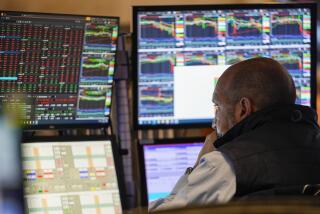Hearts Pounding at Midyear, the Pros Take Pulse
Having guided his stock mutual fund to a 40% gain so far this year--thanks to a heavy investment in red-hot technology stocks--Ron Elijah admits to feeling more than the usual pangs of worry.
“I live in fear every day that it’s going to be over,” he says of the dramatic 1995 surge in tech issues. “But when we go back and check with the companies, we find that the demand [for computers and other tech equipment] is still there.”
Elijah, who manages the $920-million Robertson Stephens Value Plus Growth fund in San Francisco, epitomizes the quandary for many investors at midyear: Yes, the market is up sharply, maybe too much so for such a short period of time. Yet the trends in corporate earnings and interest rates still appear to be in many stocks’ favor.
Even if Federal Reserve Board policy-makers, meeting today, fail to cut short-term rates as hoped, the bullish argument is that the stock market can live with current rates, provided the economy stays on a modest growth track.
Is that logical--or a classic case of greed-over-fear delusion by investors too caught up in euphoria to recognize a market top?
*
Here, four Wall Street pros explain how they’re structuring their portfolios for the second half of the year, after the first half’s market surge:
* Robertson Stephens’ Elijah: Although he concedes that his fund’s growth--from $130 million to $920 million in six months--has the earmarks of mania, Elijah says the sensational sales and earnings outlook of top technology firms justifies investors’ interest and the stocks’ big gains.
In fact, he says many of the stocks actually are cheaper today--relative to earnings and interest rates--than they were a year ago, when earnings were lower and rates were much higher.
So he refuses to part with shares of Intel, Micron Technology, Compaq, Applied Materials and other tech leaders that make up 70% of his fund, despite concern that a nasty bout of profit-taking is overdue. “I’m an investor. I can’t trade these. I’m not smart enough,” Elijah says.
His reward for holding on, he boldly predicts, will be a further price gain of 50% in many tech stocks between now and 1996.
* Paul Wick, manager, Seligman Communications & Information stock fund, New York: Wick’s reputation as one of the hottest veteran hands in the tech sector helped balloon his fund from $400 million at the end of ’94 to $2.4 billion on June 30. And with that, Wick closed the fund to new investors, after producing a 48% first-half return.
Wick agrees there are definite signs of speculative excess in some corners of the tech sector, especially the booming new-issues market. “That looks unsustainable to me,” he says.
But like Elijah, Wick finds it difficult to worry about major names like Intel, Advanced Micro Devices, Hewlett-Packard and disk maker Komag, all selling for less than 20 times estimated 1996 earnings per share--and still growing faster than most companies their size. “If you look at some of the bigger companies, you still see reasonable valuations,” Wick says.
* Kent Simons, co-manager, Neuberger & Berman Guardian stock fund, New York: Simons, too, has had to invest a wave of cash this year from new investors, swelling the Guardian fund’s assets to $4 billion. And he has picked stocks well enough to produce a handsome first-half return: up 22.3%, better than the approximate 20% total return of the Standard & Poor’s 500 stock index.
But with that record to protect, Simons now is shifting his portfolio. He has trimmed some tech and financial stocks in favor of beaten-down industrial names like Ford, GM, Chrysler, cardboard maker Stone Container, and other firms likely to get a lift if the economy’s pace picks up.
Drawn naturally to potential bargain stocks with depressed price-to-earnings ratios, Simon says of his portfolio today: “We’re either sanguine about the earnings outlook for the stocks we own, or we think the stocks have reached such a level that, even if earnings falter, the damage has already been done.”
* James Engle, chief investment officer, Wood, Struthers & Winthrop, New York: Engle doesn’t dispute the growth potential in the technology business. But he worries that earnings expectations now are so high that any disappointment will massacre the tech sector. “With my money I wouldn’t be chasing those stocks,” he says.
Instead, like Simons, Engle is looking for true bargains among stocks that investors have, for one reason or another, kept a lid on despite decent earnings growth. In that category he likes conglomerate Loews Corp. (insurance, tobacco, hotels) and cigarette and cookie giant RJR Nabisco, which he notes boasts of a current dividend yield of 5.4%--nearly as much as the average money market mutual fund.
He also advises investors to keep their eyes on the bond market. If an improving economy pushes long-term Treasury bond yields later this year to 7% or better from their current 6.2% to 6.6% range, it’ll be time to buy, Engle says. An aging population and global disinflationary pressures mean that “long term, the bond market is going to be a very good place to be.”
(BEGIN TEXT OF INFOBOX / INFOGRAPHIC)
Road to 5,000
Here are the five best- and five worst-performing stocks among the 30 Dow Jones industrial stocks this year (the Dow itself is up 19.6%):
LEADERS
1995 Stock change McDonald’s +33.3% IBM +32.8% Boeing +31.1% Eastman Kodak +30.6% Merck +30.2%
LAGGARDS
1995 Stock change Bethlehem Steel -6.9% Woolworth +0.8% AT&T; +6.7% Chevron +7.0% 3M Co. +8.0%
More to Read
Inside the business of entertainment
The Wide Shot brings you news, analysis and insights on everything from streaming wars to production — and what it all means for the future.
You may occasionally receive promotional content from the Los Angeles Times.









